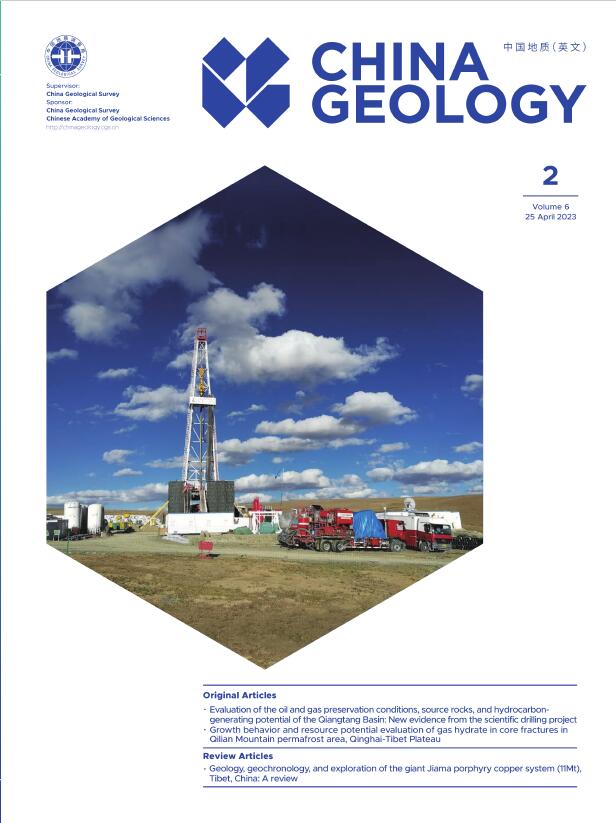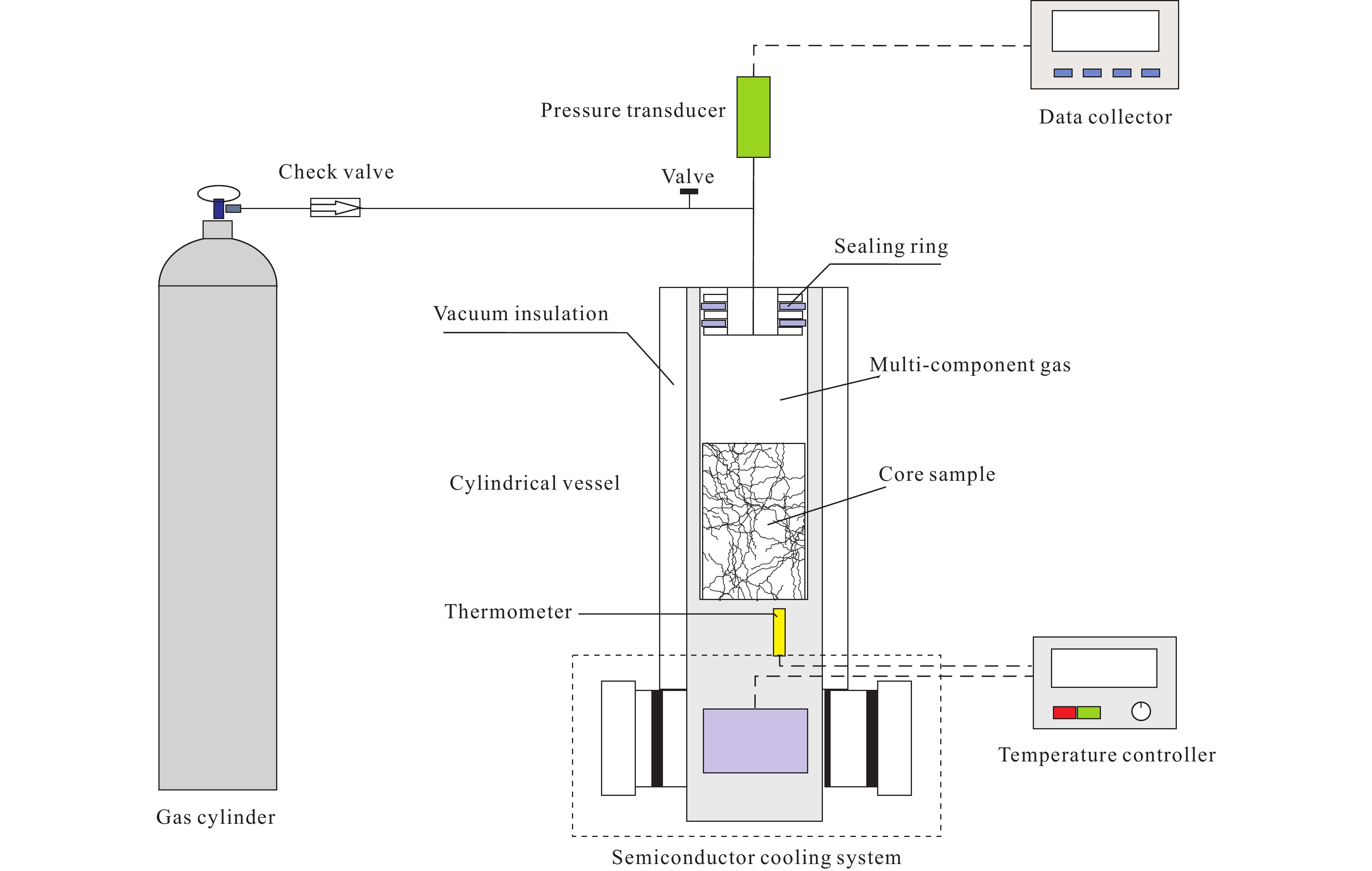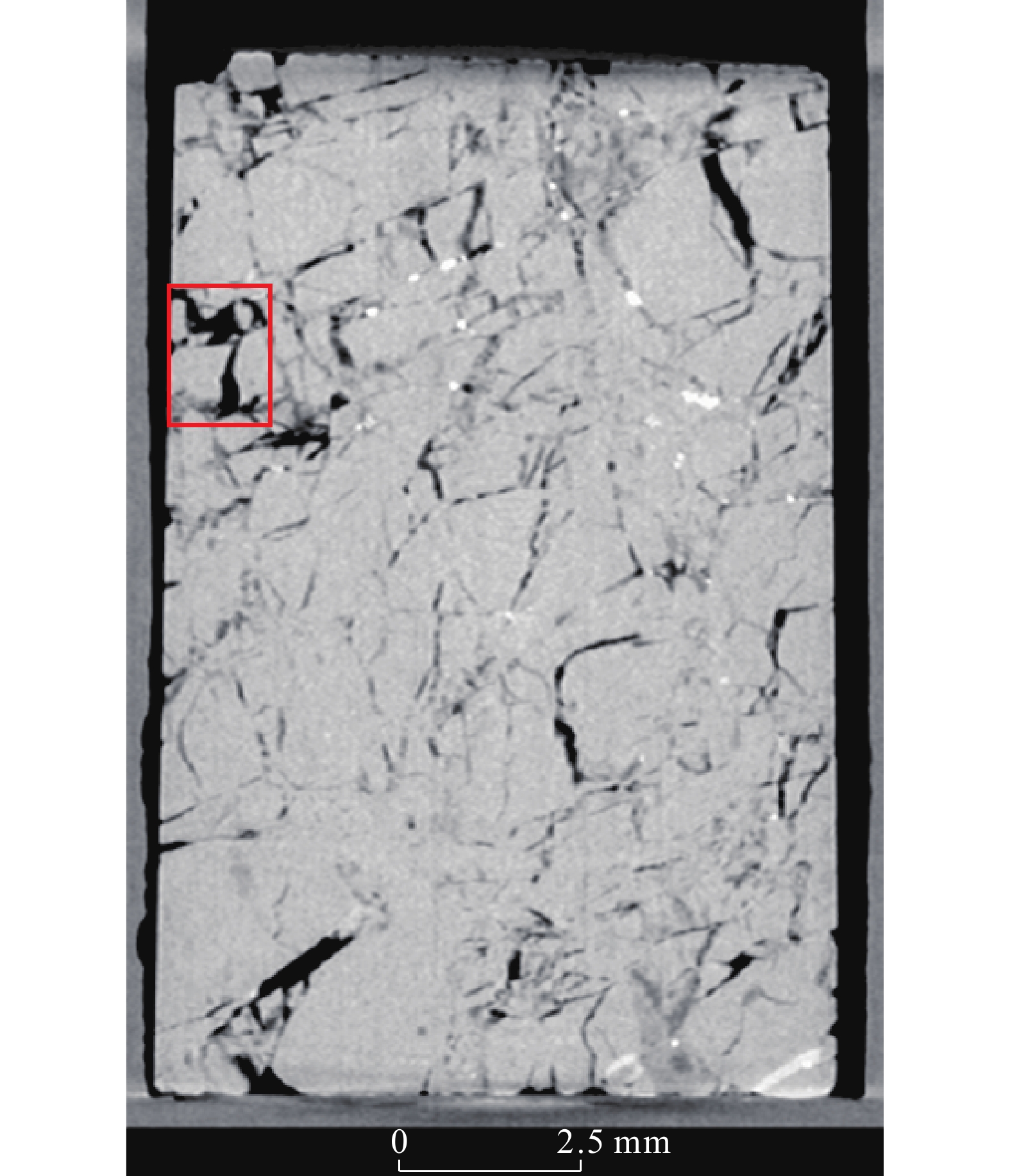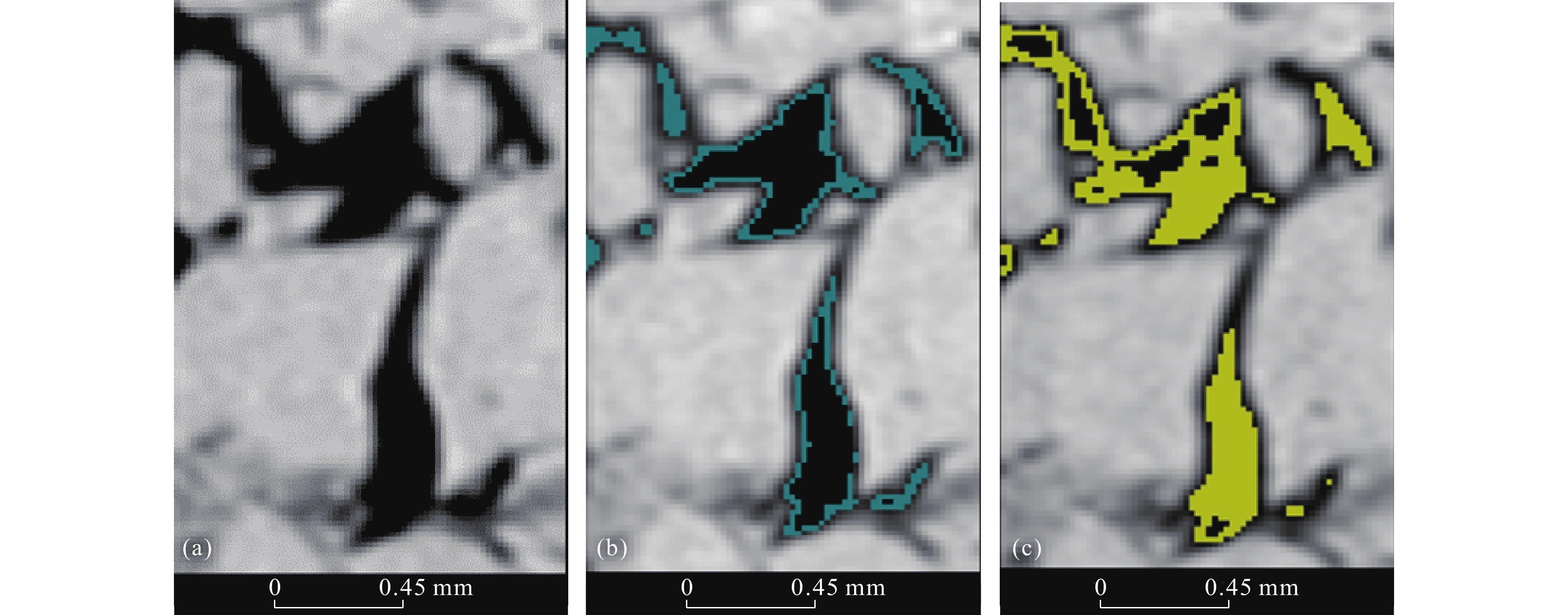| Citation: | Qing-guo Meng, Chang-ling Liu, Zhen-quan Lu, Xi-luo Hao, Cheng-feng Li, Qing-tao Bu, Yun-kai Ji, Jia-xian Wang, 2023. Growth behavior and resource potential evaluation of gas hydrate in core fractures in Qilian Mountain permafrost area, Qinghai-Xizang Plateau, China Geology, 6, 208-215. doi: 10.31035/cg2023021 |
Growth behavior and resource potential evaluation of gas hydrate in core fractures in Qilian Mountain permafrost area, Qinghai-Xizang Plateau
-
Abstract
The Qilian Mountain permafrost area located in the northern of Qinghai-Xizang Plateau is a favorable place for natural gas hydrate formation and enrichment, due to its well-developed fractures and abundant gas sources. Understanding the formation and distribution of multi-component gas hydrates in fractures is crucial in accurately evaluating the hydrate reservoir resources in this area. The hydrate formation experiments were carried out using the core samples drilled from hydrate-bearing sediments in Qilian Mountain permafrost area and the multi-component gas with similar composition to natural gas hydrates in Qilian Mountain permafrost area. The formation and distribution characteristics of multi-component gas hydrates in core samples were observed in situ by X-ray Computed Tomography (X-CT) under high pressure and low temperature conditions. Results show that hydrates are mainly formed and distributed in the fractures with good connectivity. The ratios of volume of hydrates formed in fractures to the volume of fractures are about 96.8% and 60.67% in two different core samples. This indicates that the fracture surface may act as a favorable reaction site for hydrate formation in core samples. Based on the field geological data and the experimental results, it is preliminarily estimated that the inventory of methane stored in the fractured gas hydrate in Qilian Mountain permafrost area is about 8.67×1013 m3, with a resource abundance of 8.67×108 m3/km2. This study demonstrates the great resource potential of fractured gas hydrate and also provides a new way to further understand the prospect of natural gas hydrate and other oil and gas resources in Qilian Mountain permafrost area.
-

-
References
He XL, Liu CL, Meng QG, Lu ZQ, Wen HJ, Li YH, Zhang SL, Wang JT. 2015. Gas composition of hydrate-bearing cores in Juhugeng drilling area in Qinghai and its indicative significance. Geoscience, 29(5), 1194–1200 (in Chinese with English abstract). doi: 10.3969/j.issn.1000-8527.2015.05.024. Hu GW, Li CF, Ye YG, Liu CL, Zhang J, Diao SB. 2014. Observation of gas hydrate distribution in sediment pore space. Chinese Journal of Geophysics, 57(5), 1675–1682 (in Chinese with English abstract). doi: 10.6038/cjg20140530. Huang X, Zhu YH, Wang PK, Guo XW. 2011. Hydrocarbon gas composition and origin of core gas from the gas hydrate reservoir in Qilian Mountain permafrost. Geological Bulletin of China, 30(12), 1851–1856 (in Chinese with English abstract). doi: 10.3969/j.issn.1671-2552.2011.12.006. Jin S, Takeya S, Hayashi J, Nagao J, Kamata Y, Ebinuma T, Narita H. 2004. Structure analyses of artificial methane hydrate sediments by microfocus X-ray Computed Tomography. Japanese Journal of Applied Physics, 43(8A), 5673–5675. doi: 10.1143/jjap.43.5673. Kvenvolden KA. 1988. Methane hydrate - A major reservoir of carbon in the shallow geosphere? Chemical Geology, 71(13), 4151. doi: 10.1016/0009-2541(88)90104-0. Li CF, Hu GW, Ye YG, Liu CL, Cheng J, Zhang LK, Zheng RE. 2013. Microscopic distribution of gas hydrate in sediment determined by X-ray computerized tomography. Journal of Optoelectronics · Laser, 24(3), 551–557 (in Chinese with English abstract). Li CF, Hu GW, Zhang W, Ye YG, Liu CL, Li Q, Sun JY. 2016. Influence of foraminifera on formation and occurrence characteristics of natural gas hydrates in fine-grained sediments from Shenhu area, South China Sea. Science China (Earth Sciences), 59(11), 2223–2230. doi: 10.1007/s11430-016-5005-3. Li CF, Liu CL, Hu GW, Sun JY, Hao XL, Liu LL, Meng QG. 2019. Investigation on the Multiparameter of Hydrate-Bearing Sands Using Nano-Focus X-Ray Computed Tomography. Journal of Geophysical Research-Solid Earth, 124(3), 2286–2296. doi: 10.1029/2018jb015849. Li CF, Liu CL, Meng QG, Hu GW, Zhang W, Lu ZQ, Wen HJ, Li YH, Wang WC. 2015. CT image characterization of pores and fissures in rock core from Juhugeng gas hydrate area in Qinghai. Geoscience, 29(5), 1189–1193 (in Chinese with English abstract). doi: 10.3969/j.issn.1000-8527.2015.05.023. Li JF, Ye J, Qin X, Qiu H, Wu N, Lu H, Xie W, Lu J, Peng F, Xu Z, Lu C, Kuang Z, Wei J, Liang Q, Lu H, Kou B. 2018. The first offshore natural gas hydrate production test in South China Sea. China Geology, 1(1), 5–16. doi: 10.31035/cg2018003. Li YH, Wang WC, Lu ZQ, Chen X, Fan HJ. 2015. Preliminary evaluation on gas hydrate resources in Sanlutian of Muli, Qinghai. Geoscience, (5), 1251–1258 (in Chinese with English abstract). doi: 10.3969/j.issn.1000-8527.2015.05.030. Liu CL, Meng QG, He XL, Li CF, Ye YG, Lu ZQ, Zhu YH, Li YH, Liang JQ. 2015. Comparison of the characteristics for natural gas hydrate recovered from marine and terrestrial areas in China. Journal of Geochemical Exploration, 152, 67–74. doi: 10.1016/j.gexplo.2015.02.002. Lu ZQ, Wu BH, Jin CS. 2007. A method for gas hydrate resource estimation—an example of preliminary estimation of gas hydrates in the northern continental slope, South China Sea. Petroleum Geology & Experiment, 29(3), 319–323 (in Chinese with English abstract). doi: 10.3969/j.issn.1001-6112.2007.03.019. Lu ZQ, Zhu YH, Zhang YQ, Wen HJ, Li YH, Jia ZY, Liu CL, Wang PK, Li QH. 2010a. Basic geological characteristics of gas hydrates in Qilian Mountain permafrost area, Qinghai Province. Mineral Deposits, 29(1), 182–191 (in Chinese with English abstract). doi: 10.3969/j.issn.0258-7106.2010.01.017. Lu ZQ, Zhu YH, Zhang YQ, Wen HJ, Li YH, Wang PK. 2010b. Estimation method of gas hydrate resource in the Qilian Mountain permafrost area, Qinghai, China—a case of the drilling area. Geological Bulletin of China, 29(9), 1310–1318 (in Chinese with English abstract). doi: 10.3969/j.issn.1671-2552.2010.09.007. Meng QG, 2019. Research on the multi-component gas hydrates: Structure characteristics, formation and dissociation process. Beijing, Chinese Academy of Geological Sciences, PhD thesis, 1‒137 (in Chinese with English abstract). Meng QG, Liu CL, He XL, Ye YG, Zhu YH, Xia N. 2011. Laser-Raman spectroscopy characteristics of natural gas hydrates from Qilian Mountain permafrost. Geological Bulletin of China, 30(12), 1863–1867 (in Chinese with English abstract). doi: 10.3969/j.issn.1671-2552.2011.12.008. Meng QG, Liu CL, Li CF, Hao XL. 2022. Experimental study on the forming process of multi-component gas hydrates in Qilian Mountain permafrost area. Marine Geology Frontiers, 38(1), 72–79 (in Chinese with English abstract). doi: 10.16028/j.1009-2722.2020.128. Meng QG, Liu CL, Li CF, He XL, Wang FF, Lu ZQ, Wen HJ, Li YH, Wang WC. 2015. Raman spectroscopic characteristics of natural gas hydrates from Juhugeng drilling area, Qinghai. Geoscience, 29(5), 1180–1188 (in Chinese with English abstract). doi: 10.3969/j.issn.1000-8527.2015.05.022. Milkov AV. 2004. Global estimates of hydrate-bound gas in marine sediments: how much is really out there? Earth-Science Reviews, 66(3), 183‒197. doi: 10.1016/j.earscirev.2003.11.002. Su K, Zhang GB, Sun YH, Li SL, Guo W. 2016. Formation mechanism and phase state of hydrates in fractured layers of permafrost. Petroleum Drilling Techniques, 44(2), 93–98 (in Chinese with English abstract). doi: 10.11911/syztjs.201602016. Sun YB, Zhao TH, Cai F. 2013. Gas hydrate resource assessment abroad and its implications. Marine Geology Frontiers, (1), 27–35 (in Chinese with English abstract). Tian M, 2018. Study on formation and decomposition process of mixed gas hydrate. Qingdao, Qingdao University, Master thesis, 1‒52 (in Chinese with English abstract). Wang F, Li HJ. 2010. Resource assessment methods of gas hydrate accumulations in gulf of Mexico. Marine Geology Letters, 26(3), 59–66 (in Chinese with English abstract). doi: 10.16028/j.1009-2722.2010.03.008. Wang PK, Zhu YH, Lu ZQ, Bai MG, Huang X, Pang SJ, Zhang S, Liu H, Xiao R. 2019. Research progress of gas hydrates in the Qilian Mountain permafrost, Qinghai, Northwest China: Review. Scientia Sinica Physica, Mechanica and Astronomica, 49(3), 034606 (in Chinese with English abstract). doi: 10.1360/SSPMA2018-00133. Wang PK, Zhu YH, Lu ZQ, Guo XW, Huang X. 2011. Gas hydrate in the Qilian Mountain permafrost and its distribution characteristics. Geological Bulletin of China, 30(12), 1839–1850 (in Chinese with English abstract). doi: 10.3969/j.issn.1671-2552.2011.12.005. Ye JL, Qin XW, Xie WW, Lu HL, Ma BJ, Qiu HJ, Liang JQ, Lu JA, Kuang ZG, Lu C, Liang QY, Wei SP, Yu YJ, Liu CS, Li B, Shen KX, Shi HX, Lu QP, Li J, Kou BB, Song G, Li B, Zhang HE, Lu HF, Ma C, Dong YF, Bian H. 2020. The second natural gas hydrate production test in the South China Sea. China Geology, 3(2), 197–209. doi: 10.31035/cg2020043. Zhang L. 2016. Determination and applications of rock quality designation (RQD). Journal of Rock Mechanics and Geotechnical Engineering, 8(3), 389–397. doi: 10.1016/j.jrmge.2015.11.008. Zhang W, Li CF, Liu CL, Hu GW, Meng QG, Huang XD, Zhao SJ. 2016. Identification technology of the CT images for distinguishing the boundary condition of methane hydrate in porous media. CT Theory and Applications, 25(1), 13–22 (in Chinese with English abstract). doi: 10.15953/j.1004-4140.2016.25.01.02. Zhou YW, Guo DX, Qiu GQ, 2000. Permafrost in China. Beijing, Science Press, 329‒353. (in Chinese) Zhu YH, Pang SJ, Xiao R, Zhang S, Lu ZQ. 2021. Natural gas hydrates in the Qinghai-Xizang Plateau: Characteristics, formation, and evolution. China Geology, 4(1), 17–31. doi: 10.31035/cg2021025. Zhu YH, Zhang YQ, Wen HJ, Lu ZQ, Jia ZY, Li YH, Li QH, Liu CL, Wang PK, Guo XW. 2010. Gas hydrates in the Qilian Mountain permafrost, Qinghai, Northwest China. Acta Geologica Sinica (English Edition), 84(1), 1–10. doi: 10.1111/j.1755-6724.2010.00164.x. -
Access History

-
Figure 1.
Schematic diagram of the experimental device.
-
Figure 2.
X-CT images showing the changes during the growth and dissociation of hydrates at the same cross section in core sample DK2-142 m. a‒dry sample; b‒wet sample; c‒f‒hydrate-bearing samples with hydrate saturation 96.8%; 42.9%; 24.3% and 5.3%, respectively.
-
Figure 3.
The vertical profile of the core sample DK2-266.8 m. The magnification area of the red rectangle is shown in Fig. 4.
-
Figure 4.
Hydrate growth in local fractures in core sample DK2-266.8m. a‒dry sample; b‒wet sample; c‒hydrate-bearing sample with hydrate saturation 60.67%.





 DownLoad:
DownLoad:


